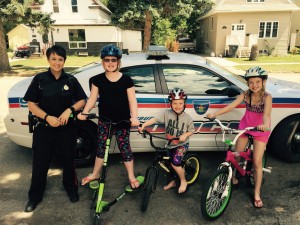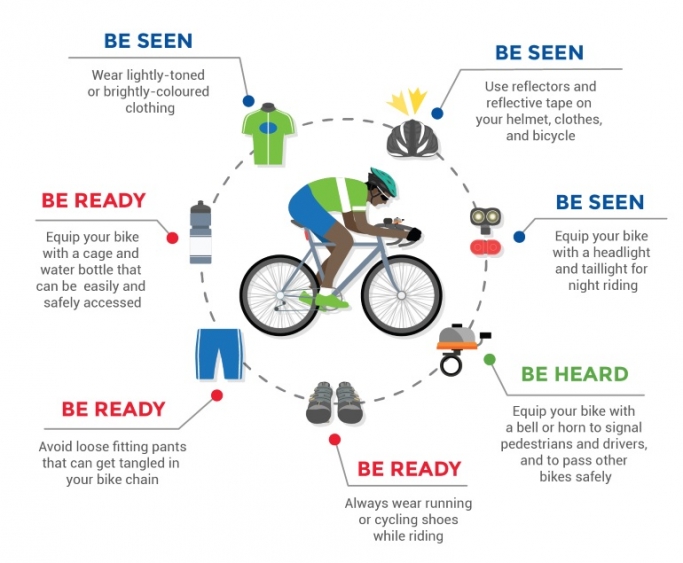
The safety of all users of the road is important, but the safety of our youth who bicycle is particularly important to us.
Under the provisions of the City Traffic Bylaw and the Traffic Safety Act cyclists must obey all rules of the road. These include; stop signs, traffic lights, signaling and riding at night with a light. People over 12 years of age found to be in violation of these rules can face prosecution.
While helmet use is not required under the law there should be little doubt that it is the best practice for all cyclists.
What to Teach your Children about Bicycle Safety
Starting out
Make sure your child’s bike and helmet are the right size. He or she should be able to straddle the bike with both feet on the ground; a bike that is too big or too small is a safety hazard. As a minimum, your child’s first bike should be equipped with a bell and reflectors.
For young children, set the following hard and fast rules:
- No playing on the road.
- No riding on busy streets.
- No riding at night.
- Stop for all stop signs.
- Ride on the right with traffic.
Common dangers
The majority of bicycle injuries do not involve motor vehicles. Most are falls, collisions with stationary objects, and collisions with other bikes or pedestrians, which result from the bicyclist losing control, and most occur less than five blocks from home, in familiar surroundings.
But the most serious incidents involve motor vehicles.
Following are some of the most common causes of bicycle injuries:
Driveway ride-out
A youngster rides out of the driveway and gets hit by a car. Very often these incidents involve younger children: the median age is less than 10.
Does your driveway present obstructions to the view of passing motorists, such as bushes or trees? If so, trim them back. Most importantly, teach your child about driveway safety. Go outside to the driveway and have him or her practice the following steps:
- Stop before entering the street.
- Scan left, then right for traffic.
- If there’s no traffic, proceed into the roadway.
Running the stop sign
Take your child to a stop sign and explain what it means, emphasizing the following:
- Stop at all stop signs regardless of what is happening.
- Scan both directions for traffic.
- Wait for any cross traffic to clear.
- Proceed when safe.
Above all, practice what you preach!
Turning without warning
Teach your children to walk their bikes across busy streets, at least until they have some advanced training and are old enough to understand traffic. In the meantime, for residential street riding, you can teach them to always scan and signal before turning left. Go to a playground to practice riding along a straight paint line while scanning behind. Stand alongside and hold up two fingers on your hand after the child rides by. Call their name. After 10 or 15 minutes of practice a 10 year old should be able to look behind and identify how many fingers you are holding up, all without swerving.
After dark
Most crashes in which a car coming up from the rear hits a bike while overtaking happen at night. These overtaking accidents can be serious. Most, however, involve older cyclists; the median age is about 20.
Rule out night riding for your youngster. It requires special skills and equipment. Few kids have either. Make your child understand that, if he or she gets caught out after dark on a bike, the only thing to do is to call you for a ride home.
Following the leader
Many car/bike collisions take place when children are following each other. The first one may run a stop sign and get through. The second one may get hit. This Group Think behavior is hard to counter.
Teach your child always to assess the traffic situation for him or herself. When a group is riding around, each cyclist should stop for stop signs. Each one should scan to the rear before making left turns.
Head injuries

Less than 20 per cent of reported bicycle injuries involve collisions with cars. Most occur in falls, or as a result of riders losing control. A bad fall can result from a skid, catching a wheel in a crack or even getting a shoelace caught in the chain.
In a spill, the forehead usually hits the ground first. Head injuries cause most bicycle-related deaths and can result in serious injury such as brain damage. Up to 88 per cent of serious head injuries could be prevented by wearing a helmet. It is critical for your child to wear a bike helmet that fits properly and is certified by CSA International.
When choosing a helmet, your child should try on several helmets carefully. Level the helmet over your child’s forehead and adjust the chin strap to fit snugly and comfortably. It should protect the forehead without slipping forward or backward; and it should not move unless the scalp moves. A trained salesperson will help you ensure the fit is right.
Insist your child always wears a helmet when riding. (It goes without saying that parents must set an example by always wearing theirs when cycling.) Remember, a helmet only works when you wear it!
Never forget that example is the best teacher.
- Get into the helmet habit.
- Always stop at stop signs.
- Practice what you teach.
For more information and additional resources, visit http://www.bikesafety.caa.ca/ or contact Weyburn Police Service at 306-848-3250.





